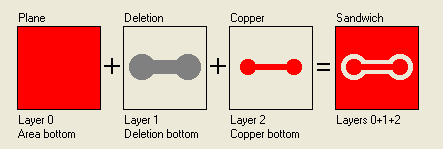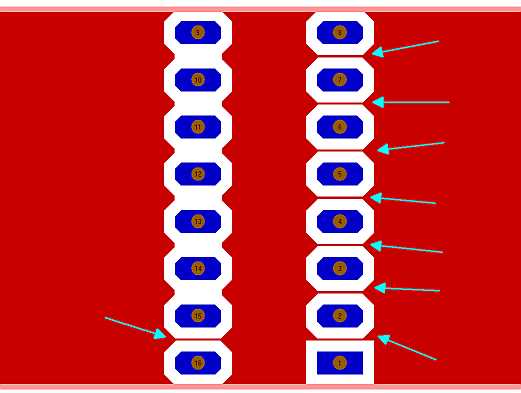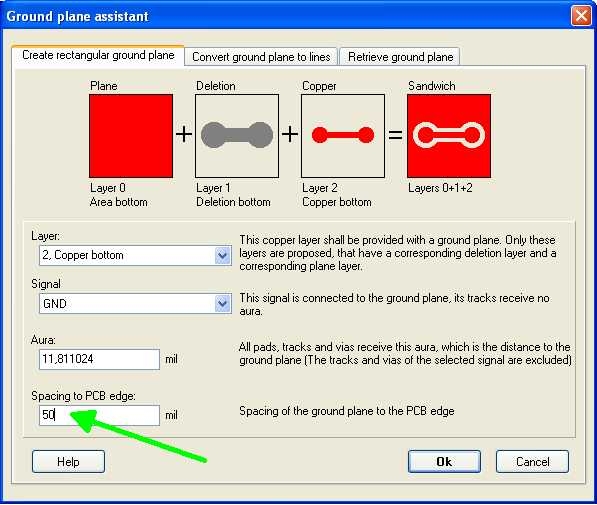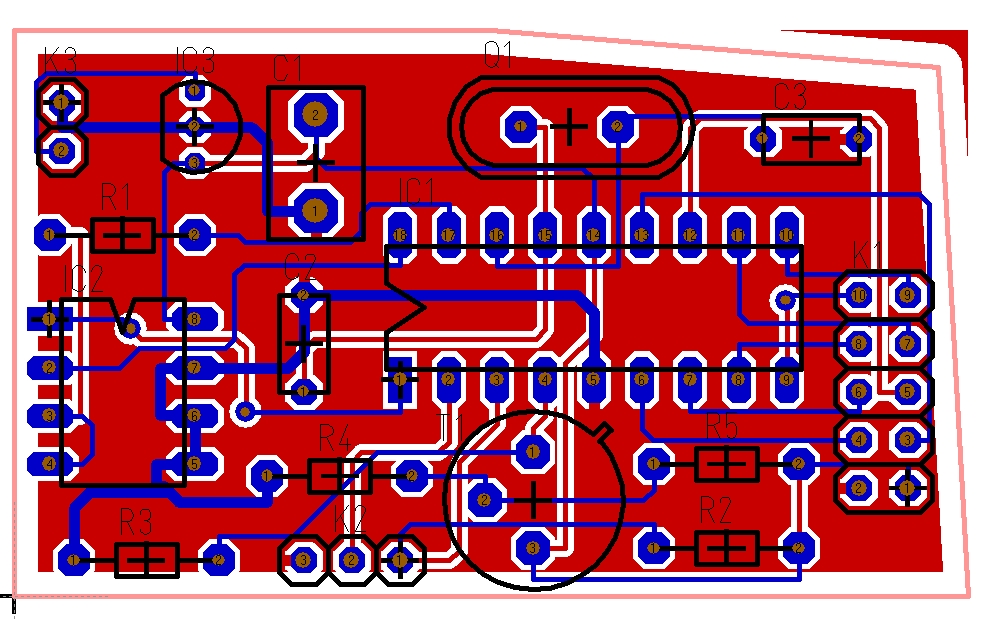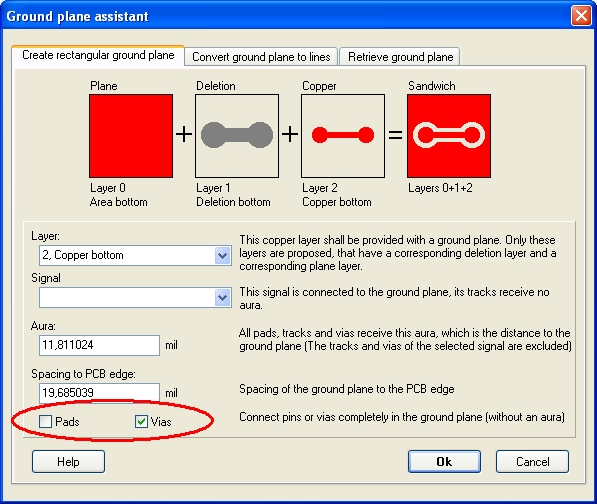Difference between revisions of "Groundplane"
(→Masse-Trennung) |
|||
| Line 125: | Line 125: | ||
| − | [[Image: massetrennung3_e.jpg]]<br>Bild: Der Dialog "Masse-Trennung". | + | [[Image: massetrennung3_e.jpg]]<br>Bild: Der Dialog "Masse-Trennung".<br><br> |
Revision as of 14:54, 22 January 2014
I have got a question at this point...
Further links:
How to create a common groundplane by the use of the Groundplane assistant
How to create a freehand groundplane
How to create several freehand groundplanes on one layer
How to create a gridded groundplane
How to remove groundplane islands
How to create a Spacing between GND copper and edge of the board
Contents
General
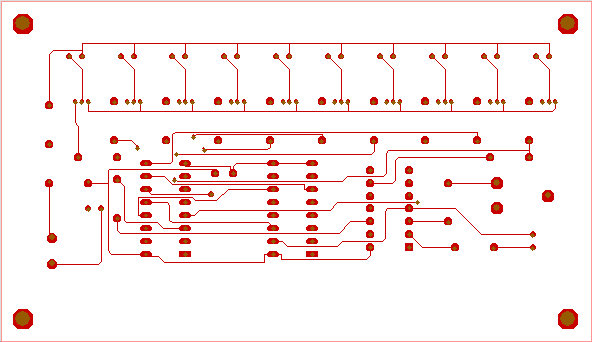
Image 1: A layout without groundplane
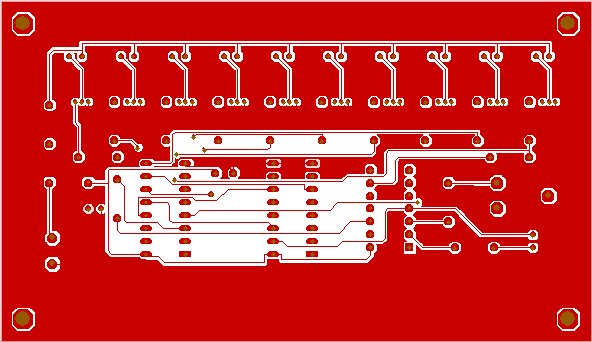
Image 2: The same layout with groundplane (red)
While working with high frequency signals, it is often required to shield them with ground wires or to embed them in ground planes. Using the TARGET 3001! groundplane assistant a groundplane can be generated in realtime on button click. You may generate them solid or gridded. Groundplane islands can be rubbed out.
Groundplane construction in TARGET 3001!
A groundplane in TARGET 3001! is constructed out of three layers:
- The shape of the groundplane (any shape is possible) is defined upon an "area" layer
- The spacings (auras) protecting non-GND-leading signals are defined on a "deletion" layer
- the "copper" layer upon which the groundplane at the end shall appear
Signal tracks not leading the GND signal get separated from the GND plane by a spacing which in the TARGET 3001! nomenclatura is called the aura of a signal. Signal tracks which lead the GND signal get embedded into the groundplane for the very most part.
The area and the deletion layer each must be assigned to the desired copper layer. E.g. if the groundplane shall appear upon layer 2=copper bottom, the area and the deletion layer each must be assigned to this layer 2. The advantage of the TARGET 3001!-graphical area calculation is that any modifications regarding the groundplane area is immediately visible on screen without any time loss.
Tracks leading a groundplane signal always should be routed...
... prior to the generation of the groundplane. Otherwise it is unsure whether a real connection is done or whether it is wide enough. This advice is given though from TARGET 3001! version V15 the groundplane itself effects internal connection from pad to pad (the airwires don't remain). In earlier versions the principle was: "You must rout the airwires by signal tracks." Keep this principle in V15 though because it might happen that the ground signal is not carried throughout all areas of your groundplane because of missing or too narrow copper corridors. The following images will illustrate it.
So in this simple case an interception of the groundplane is obvious. Such interceptions can meander through complex designs and are difficult to figure out at the end. Up to version 14 TARGET 3001! demands that the groundplane signals (GND or any other signal of a groundplane potential), always need to be contacted by routing although those signals might be completely embedded into the groundplane and thus come out invisible. V15 gives more freedom to the user in this point but nevertheless we recommend to always rout ground signals:
In case you can not fulfill the "minimum spacing" requirements, you maybe need to relocate components. Only by this acting all groundplane connections can safely be created. Besides - those little ligaments within the GND soldering pads crossing the pad aura are created by the function Thermal Pads.
Unfortunately it is difficult to figure out whether a connection to ground really is created by a polygon in a sufficient way:
On the left you see only a narrow ligament - sure a reason for an error message. On the right hand side you see more of those ligaments. Now the question is: putting out an alert or assume sufficient? In TARGET 3001! currently you don't need to route the complete GND signal but you should do so. That is to make sure that copper corridors between all sections of your ground plane will have a sufficient width.
Alternatively you will need to visually inspect your groundplane properly wheter all sections have sufficient signal access.
Groundplanes on PCBs not rectangular
Let's say you have imported a board outline by DXF and now wish to create a matching groundplane. The groundplane assistant can do only rectangular groundplanes covering the whole figure. This is normally no problem, because exceeding parts of the rectangle later it get milled away. You can advise the groundplane assistant to stay back from the edge a certain distance:
This is the result:
The "stay back" line is a copy of your outline double the width of your "stay back" command created on the deletion layer. You can overdraw the exceeding parts by filled geometrical figures on this deletion layer too. But this is only for beauty reasons. For copper top it is layer "15, Deletion top", for copper bottom it is layer "1, Deletion bottom". The same with inner layers.
But sure you can create any groundplane shape you like. Copy your DXF imported outline (which you should have on layer "23, Outline") to layer "0, Area bottom" for a groundplane on copper bottom or to layer "14, Area top" for a groundplane on copper top. Now fill it with matching geometrical figures (there is no "copper pour" on one click). Now highlight the complete groundplane (maybe you can fade out all other layers), press keyboard key [E] for opening the edition dialog, select the desired kinds of figures and assign the GND signal to all of them on one strike.
Please have a look here how to create a custom groundplane: Freehand groundplane
In general a groundplane is connected by the aura=0 of the GND signal. Soldering pads normally keep their aura to prevent the heat from vanishing into the GND area too quick which might cause non connective soldering (also see Thermal Pads). From version 15 you can decide for a soldering pad or a via leading a ground potential, whether to keep their aura or not. in the last case the pad/the via would be connected (embedded) completely to the groundplane. For this reason tick or untick the boxes in the dialog:
Masse-Trennung
Vielleicht wollen Sie innerhalb einer Massefläche eine zusätzliche Fläche abgrenzen, die ein anderes Potential hat. Löschen Sie bei Ihrer bestehenden Massefläche zunächst das Signal indem Sie nach Doppelklick auf die Massefläche im sich öffnenden Dialog den Signalnamen wegnehmen. Zeichnen Sie nun mit den Zeichenfunktionen den gewünschten Umriss auf die Lösch-Ebene. Wählen Sie dazu die Zeichenfunktion und schweben Sie in der Sidebar rechts auf die gewünschte Ziffer, zum Beispiel 1 für Lösch unten oder 15 für Lösch oben. Klicken Sie mit der rechten Maustaste M2. Jetzt ist die Lösche-Ebene als Zeichenebene aktiviert und Sie können Ihre Figur absetzen.
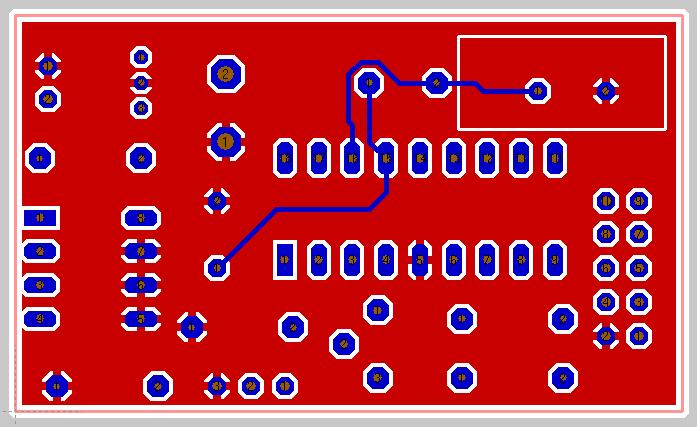
Bild: Rechteckige Löschung rechts oben.
Wählen Sie jetzt den Menüpunkt Aktionen/Masseflächen/Masse-Trennung.... Der folgende Dialog öffnet sich:
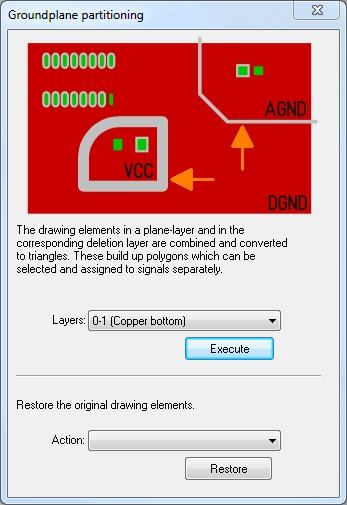
Bild: Der Dialog "Masse-Trennung".
Wählen Sie im Dialog, ob Sie eine Masse-Trennung auf Kupfer unten oder Kupfer oben vornehmen wollen: Ebenen 0 und 1 (Lötseite) oder Ebenen 14 und 15 für die Bestückungsseite (oben).
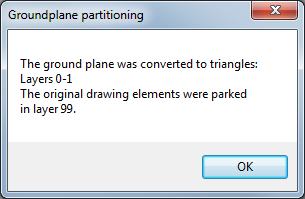
Bild:Die Massetrennung hat stattgefunden
Jede Fläche kann jetzt separat markiert und mit einem eigenen Massepotential versehen werden. [M1] auf die Fläche klicken dann [ä] wie ändern drücken und Signalnamen vergeben. Wenn Sie Ihre ursprüngliche Fläche zurück haben möchten, finden Sie sie auf Layer 99. Kopieren Sie sie und verbringen Sie sie auf Layer 0, Fläche unten oder Ebene 14, Fläche oben.
Alias: Ground, Erde, Mass, Masse, copper pour


